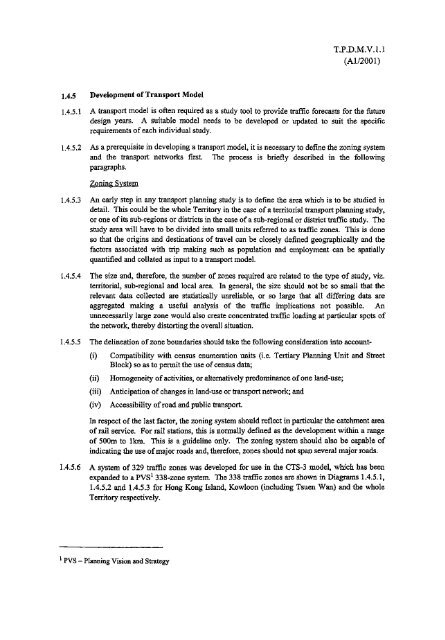Transport Planning - HKU Libraries - The University of Hong Kong
Transport Planning - HKU Libraries - The University of Hong Kong
Transport Planning - HKU Libraries - The University of Hong Kong
- No tags were found...
Create successful ePaper yourself
Turn your PDF publications into a flip-book with our unique Google optimized e-Paper software.
T.P.D.M.V.U(Al/2001)1.4.5 Development <strong>of</strong> <strong>Transport</strong> Model1.4.5.1 A transport model is <strong>of</strong>ten required as a study tool to provide traffic forecasts for the futuredesign years. A suitable model needs to be developed or updated to suit the specificrequirements <strong>of</strong> each individual study.1.4.5.2 As a prerequisite in developing a transport model, it is necessary to define the zoning systemand the transport networks first. <strong>The</strong> process is briefly described in the followingparagraphs.Zoning System1.4.5.3 An early step in any transport planning study is to define the area which is to be studied indetail. This could be the whole Territory in the case <strong>of</strong> a territorial transport planning study,or one <strong>of</strong> its sub-regions or districts in the case <strong>of</strong> a sub-regional or district traffic study. <strong>The</strong>study area will have to be divided into small units referred to as traffic zones. This is doneso that the origins and destinations <strong>of</strong> travel can be closely defined geographically and thefactors associated with trip making such as population and employment can be spatiallyquantified and collated as input to a transport model.1.4.5.4 <strong>The</strong> size and, therefore, the number <strong>of</strong> zones required are related to the type <strong>of</strong> study, viz.territorial, sub-regional and local area. In general, the size should not be so small that therelevant data collected are statistically unreliable, or so large that all differing data areaggregated making a useful analysis <strong>of</strong> the traffic implications not possible. Anunnecessarily large zone would also create concentrated traffic loading at particular spots <strong>of</strong>the network, thereby distorting the overall situation.1.4.5.5 <strong>The</strong> delineation <strong>of</strong> zone boundaries should take the following consideration into account-(i)(ii)(iii)(iv)Compatibility with census enumeration units (i.e. Tertiary <strong>Planning</strong> Unit and StreetBlock) so as to permit the use <strong>of</strong> census data;Homogeneity <strong>of</strong> activities, or alternatively predominance <strong>of</strong> one land-use;Anticipation <strong>of</strong> changes in land-use or transport network; andAccessibility <strong>of</strong> road and public transport.In respect <strong>of</strong> the last factor, the zoning system should reflect in particular the catchment area<strong>of</strong> rail service. For rail stations, this is normally defined as the development within a range<strong>of</strong> 500m to 1km. This is a guideline only. <strong>The</strong> zoning system should also be capable <strong>of</strong>indicating the use <strong>of</strong> major roads and, therefore, zones should not span several major roads.1.4.5.6 A system <strong>of</strong> 329 traffic zones was developed for use in the CTS-3 model, which has beenexpanded to a PVS 1 338-zone system. <strong>The</strong> 338 traffic zones are shown in Diagrams 1.4.5.1,1.4.5.2 and 1.4.5.3 for <strong>Hong</strong> <strong>Kong</strong> Island, Kowloon (including Tsuen Wan) and the wholeTerritory respectively.1 PVS - <strong>Planning</strong> Vision and Strategy

















